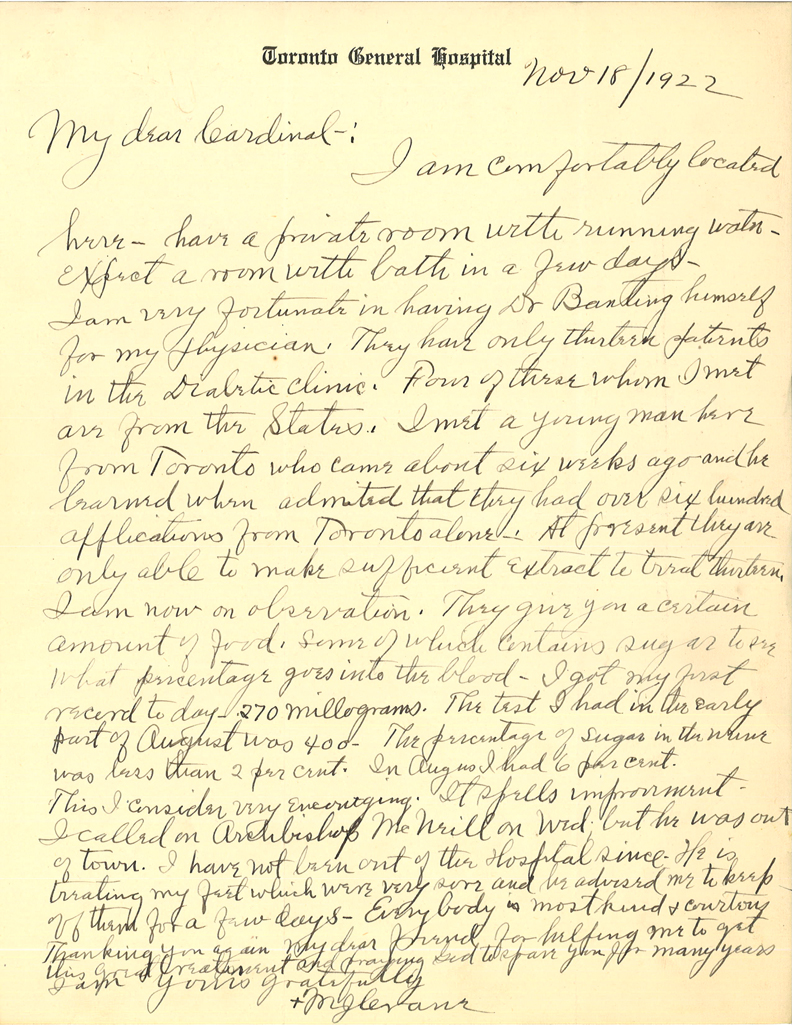November is
National Diabetes Awareness Month.
Diabetes has been known to exist since ancient times; the
first recorded mention of a disorder with its characteristics was in 1552 BC. Today's diabetics are able to live with the disease, but that wasn't always the case. Until the 20th century, diabetes was a death sentence. Life could be prolonged for a few years through diet and exercise, but ultimately nothing could be done.
In 1920, Dr. Frederick Banting, who lived in London, Ontario at the time, became interested in the relationship between the pancreas and diabetes. He brought his ideas to Professor John Macleod at the
University of Toronto. Over the next few years, he worked with Charles Best and Dr. James Collip, which led to the discovery and refinement of insulin. The first human patient to be treated was a 14 year old boy, who received insulin at the beginning of 1922, and by October 1923 insulin was made widely available. Banting and Macleod were awarded the
Nobel Prize in Physiology in 1923 for their miraculous treatment, which for the first time allowed diabetics to live a normal life.
News of the discovery spread quickly. In October 1922, before the widespread availability of insulin, Archbishop McNeil received a letter from Cardinal Dougherty, Archbishop of Philadelphia. He appealed to Archbishop McNeil to use his influence to persuade Banting to send a supply of insulin for his auxiliary bishop, Rev. M.J. Crane, who was quite ill:
 |
MN AD57.001
"The newspapers of Philadelphia have lately informed the public that Dr. Banting, of the University of Toronto, has discovered a treatment for diabetes, the medicine to be used in the treatment being called "insulin."
"It is stated that, for some months to come, a sufficient quantity of this medicine for the public at large will not be available.
"No doubt, however, a sufficient amount for an individual treatment could be secured if the proper influence were brought to bear upon Dr. Banting.
"Rt. Rev. Bishop M.J. Crane, Auxiliary Bishop of Philadelphia, is suffering from diabetes, and both he and I would consider it a great favor if Your Grace, by your influence, could prevail upon Dr. Banting to send to Bishop Crane a sufficient quantity of "insulin" for the treatment and cure of his case."
October 19th, 1922
|
Our counterparts in Philadelphia were generous enough to send us Archbishop McNeil's reply:
 |
"The news of this diabetes cure was broadcasted too soon, and one result is that Dr. Banting gets letters at the rate of about 1000 per week. Dr. Loudon saw him about the Bishop's case ... It seems the medicine does all that is claimed for it. The difficulty is to get enough of it. I beg that the diagnosis of the Bishop's present condition be sent to my address. Dr. Banting will make time for it."
From the Papers of Cardinal Dennis Joseph Dougherty, 80.4136. Philadelphia Archdiocesan Historical Research Center. |
Cardinal Dougherty's Reply:
 |
MN AD57.002
"You will notice, from Dr. Webster's letter, that the Bishop has a severe case of diabetes which is apt to result fatally in the near future, unless something be done for him.
I appreciate very highly what Your Grace has already done; and if possible I shall be still more grateful if Your Grace prevail upon Dr. Banting to send the medicine at the earliest convenience.
|
The story has an uplifting ending. Our Philadelphian counterparts also sent us Bishop Crane's update to Cardinal Dougherty:
 |
My Dear Cardinal,
I am comfortably located here - have a private room with running water - expect a room with a bath in a few days - I am very fortunate in having Dr. Banting himself for my physician.They have only thirteen patients in the Diabetic clinic. Four of these whom I met are from the States. I met a young man here from Toronto who came about six weeks ago and he learned when admitted that they had over six hundred afflictions from Toronto alone. At present they are only able to make sufficient extract to treat thirteen. I am now on observation. They give you a certain amount of food, some of which contains sugar to see what percentage goes into the blood. I got my first record today - 270 milligrams. The test I had in the early part of August was 400. The percentage of sugar in the urine was less than 2 per cent. In August I had 6 per cent. This I consider very encouraging. It spells improvement. I called on Archbishop McNeil on Wed[nesday] but he was out of town. I have not been out of the hospital since. He is treating my feet which were very sore and he advised me to keep off them for a few days. Everybody is most kind and courteous. Thanking you again my dear friend for helping me to get this good treatment and praying God to spare you for many years.
I am yours gratefully, +MJ Crane
November 18, 1922
From the Papers of Cardinal Dennis Joseph Dougherty, 80.4136. Philadelphia Archdiocesan Historical Research Center. |
Because of the intercession of Cardinal Dougherty and Archbishop McNeil, Bishop Crane was among the first patients to receive the landmark treatment. It has been almost 100 years and insulin, which was discovered here in our city, has saved the lives of millions of people around the world.




No comments:
Post a Comment